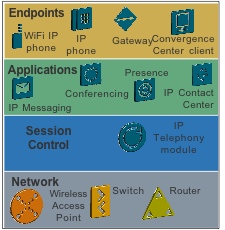Are We ready for Better Quality Audio? What are the enablers to better Quality?
There are four architectural elements in effective IP Telephony quality as shown in the figure here.
The network must support virtual LAN segmentation to separate out the voice packet streams from the bursty and delay-insensitive email and browsing traffic. The standard for vLAN is 802.1Q.
The network must also support Quality of Service in the Ethernet switching infrastructure (802.1p) so that voice packets, tagged with the QoS bit, are handled FIRST to minimize jitter and delay which translates into audio fragments to the listener.
In Wireless LAN environments, support for advanced features like 802.11e (Quality of Service) and 802.11i (strong privacy) in the air is really important. These emerging standards assure a balance between competing users, wireless networks and applications. Don't forget 802.11 is unlicensed, meaning it is meant by FCC (and dozens of other spectrum regulatory agencies around the world) decree to be shared. Two other requirements in the specialized IP Telephony-enabled Wireless LAN environment are rapid call handoffs (3Com delivers this through a proprietary technique of vLAN tunnel switching), and rogue Access Point management. Meaning, rogue AP neutralization.
It is appropriate for the session control layer to include bandwidth specification negotiation as part of the service definition discussion between endpoints in the call setup sequence. This is particularly true in proprietary implementations where the protocol between the endpoints and the session controller are encoded or proprietary.
Enabling wideband on the applications provides the basis for clear audio service during conferencing sessions and other applications, between IP phone users.
Enabling wideband and support for QoS tagging right in the codecs of the IP phones and clients at the endpoint layer are important mechanisms for assuring audio quality. If the endpoints don't support higher sampling rates, and if the endpoints don't support QoS, there's not much the network can do to assure quality audio (other than vLAN).
Gateways and interactions with gateways will probably stay at 8kHz sampling rates, because the public telephone network cannot support higher quality.









